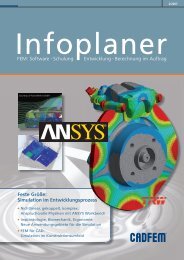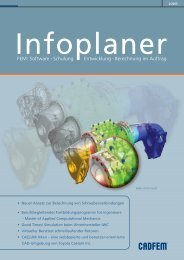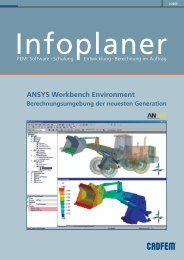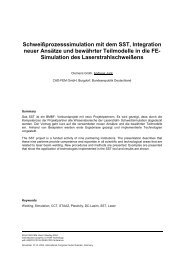ANSYS nCode DesignLife - CADFEM.CH
ANSYS nCode DesignLife - CADFEM.CH
ANSYS nCode DesignLife - CADFEM.CH
Create successful ePaper yourself
Turn your PDF publications into a flip-book with our unique Google optimized e-Paper software.
<strong>ANSYS</strong> <strong>nCode</strong> <strong>DesignLife</strong> is a powerful solution to<br />
predict fatigue life from virtual simulations, making it<br />
possible to:<br />
• Perform virtual durability assessment up front to reduce<br />
reliance on physical test and avoid costly design and tooling<br />
changes.<br />
• Perform smarter and quicker physical tests by simulating first.<br />
• Design durability into your products and reduce warranty<br />
claims.<br />
• Assess more design options, consider more realistic loading<br />
conditions and more confidently reduce cost and weight.<br />
• Standardize analysis processes to improve consistency and<br />
quality.<br />
• Seamless access to results and expanded material library<br />
from simulations within Workbench.<br />
<strong>DesignLife</strong> Standard Package<br />
Stress Life solver<br />
Enables fatigue life calculations to be made using the stress-life<br />
approach. Includes the ability to interpolate between material<br />
curves depending on the temperature. Python scripting can also<br />
be used to add new or proprietary SN methods. Primary application<br />
is high-cycle fatigue (long lives) where nominal stress controls<br />
the fatigue life.<br />
• Material models<br />
- Standard SN<br />
- SN Mean multi-curve<br />
- SN R-ratio multi-curve<br />
- SN Haigh multi-curve<br />
- SN Temperature multi-curve<br />
- Bastenaire SN<br />
- Custom SN using Python<br />
• Mean stress corrections<br />
- FKM Guidelines<br />
- Goodman<br />
- Gerber<br />
• Stress gradient corrections<br />
- FKM Guidelines<br />
- User defined<br />
• Back calculations to target life<br />
Strain Life solver<br />
Enables fatigue life predictions to be made using the local strain<br />
approach. Includes the ability to interpolate between material<br />
curves depending on the temperature at each location. Applicable<br />
to a wide range of problems including low-cycle fatigue with the<br />
local elastic-plastic strain controls the fatigue life.<br />
• FE results input<br />
- Stress<br />
- Linear strain<br />
- Stress & Strain<br />
• Material models<br />
- Standard EN<br />
- EN Mean multi-curve<br />
- EN R-ratio multi-curve<br />
- EN Temperature multi-curve<br />
• Mean stress corrections<br />
- Morrow<br />
- Smith Watson Topper<br />
• Plasticity Corrections<br />
- Neuber<br />
- Hoffman-Seeger<br />
• Multiaxial Assessment<br />
- Biaxial<br />
- 3D Multiaxial<br />
- Auto-correction<br />
• Back calculations to target life<br />
Dang Van solver<br />
Enables Dang Van safety factor calculations. The Dang Van criterion<br />
is a method of predicting the endurance limit under complex<br />
loading situations. The output from the analysis is always<br />
expressed as a safety factor not a fatigue life. Specific material<br />
parameters are calculated from tensile and torsion tests. It has<br />
primary application for engine and powertrain-type applications<br />
where there are very large numbers of loading cycles.<br />
• Multiaxial calculations using the Dang Van approach<br />
• Calculate safety factors, danger factors Tau_zero<br />
<strong>ANSYS</strong> <strong>nCode</strong> <strong>DesignLife</strong> also provides:<br />
• Selection of model subsets for analysis by property id, material<br />
group or user defined set<br />
• Multiple analysis types within the same job<br />
• Multi-stage analyses to focus in quickly on critical areas<br />
• Identification of critical areas and hotspots automatically<br />
• Robust multiaxial assessment methodology<br />
• Looping on input data for multiple calculations<br />
• Support for parallel processing (SMP)<br />
• Interactive or batch mode processing<br />
• Percent certainty of survival using material scatter data.







